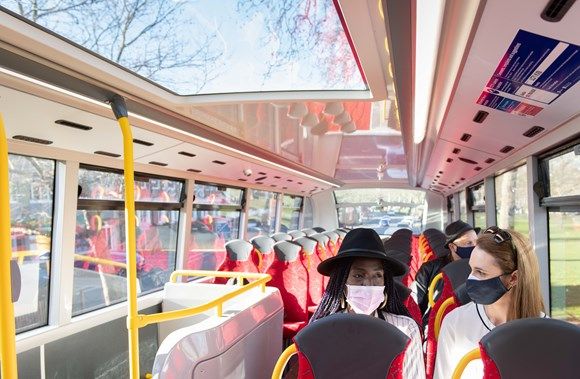Transport for London (TfL) has published its long-term plan for buses, including new, higher specification all-electric buses, which will help the capital become net zero by 2030.
Buses are already the most used form of public transport in the capital, and TfL’s Bus Action Plan will create an even more attractive alternative to car use, by focusing on five areas:
- an inclusive customer experience – a modern, relevant bus network that allows for spontaneous, independent travel, including improved customer information and bus station refurbishment; with actions including upgrading more existing bus stops to meet the wheelchair accessible standard
- safety and security – a safe, secure bus network, with no one killed on or by a bus by 2030, and with all elements of the Bus Safety Standard implemented by 2024; and ensuring all customers and staff feel confident on the bus network travelling day and night, including through improved bus driver training
- faster journeys – a faster and more efficient bus network, with journeys 10 per cent quicker than in 2015, with initiatives including the aim to introduce 25km of new and improved bus lanes by 2025
- improved connections – a bus network better suited to longer trips with better interchanges, especially in outer London; and ensuring London residents remain close to a bus stop
- decarbonisation and climate resilience – a zero-emission bus fleet to tackle climate change and improve air quality, working with operators, boroughs and suppliers to reduce the cost and difficulty of infrastructure upgrades needed to enable the transition of the bus fleet; and safeguarding the network from extreme weather conditions.
The plan can be seen in action on the route 63 from King’s Cross to Honor Oak, where new higher specification all-electric buses were launched last month.
The buses bring together a range of customer-friendly features for the first time, including a more welcoming feel, USB charge points and mobile phone holders, a larger wheelchair and buggy area and better real time travel information on board.
A new bus lane on the New Kent Road section of the route is improving journey times and reliability in line with the plan. All vehicles meet TfL’s Bus Safety Standard and feature upgraded CCTV, enhancing security.
After trials found that extending bus lane hours on London’s busiest roads cut bus journey times and helped service reliability, TfL announced in December last year that the majority of bus lanes on London’s red routes would be converted to operate 24 hours a day, seven days a week.
Cars are the largest source of road and rail emissions in London, and car traffic must drop by at least 27% by 2030 to meet London’s climate change targets. The scale of these reductions is likely to require a fairer and more sophisticated road user charging scheme, which would only be feasible with a comprehensive bus network.
The capital has one of highest number of zero emission buses in Europe, with 800 at present, and is on target to hit 10 per cent of the whole fleet this year. All new buses to the network are zero-emission and sustained Government funding could see all buses converted as early as 2030, taking 500,000 tonnes of carbon out of the transport system. Such funding from Government is critical if the benefits outlined in the plan are to be realised.
Louise Cheeseman, TfL’s Director of Buses, said: “We are excited to set out our bus strategy for the rest of this decade, which is all about creating a bus service reflective of our customers and their evolving needs, supporting a sustainable recovery from the pandemic, making London a net zero city by 2030 and improving people’s safety and wellbeing.
“Investment in buses is imperative in dealing with the climate crisis and cleaning up the toxic air that is damaging our health. Our red bus network is fundamental to preventing congestion and, more widely, is a catalyst for unlocking homes and employment in London, as well as creating green jobs across the UK. Buses are already an efficient, convenient form of public transport and London has the largest green bus fleet in western Europe, but we need to raise the bar. The Bus Action Plan sets out how we will meet the challenges now and into the future, making buses cleaner and greener, more efficient and an option for all our city’s diverse communities. Ultimately, it’s about making the bus the natural choice over the car.
“We can’t do it by ourselves, and in publishing the action plan today we’ll be well placed to start more engagement over the coming months on our shared objective of making London a better place to live.”
Emma Gibson, Chief Executive at London TravelWatch, said: “TfL is spot-on in setting out what needs to be done to get more people using the bus. Making it quicker to get from A to B is key to this, and improving journey times is a win-win as it saves TfL money which can be re-invested in bus routes, particularly in outer London. But getting more people using the bus also requires protecting existing routes, and supporting this and the wider ambitions of the Bus Action Plan can’t be done without long-term funding.”
Silviya Barrett, Head of Policy and Research at Campaign for Better Transport, said: “London’s buses are relied upon by millions, they keep the capital moving and communities connected. More modern buses, better customer information, additional bus priority lanes and plugging critical gaps in service provision will help improve passengers’ experiences and enable more people to make buses part of their everyday journeys. This will support the economic recovery and help tackle congestion, air pollution and carbon emissions. To make this happen, it is vitally important that TfL has the sustainable funding deal it needs to keep investing in, and promoting a return to, public transport post-pandemic.”
Harry Rushworth, Chair of TfL Youth Panel, said: “Buses play a critical role in the lives of young Londoners; providing convenient, reliable, and affordable access to education and employment. It is therefore essential that, as London undergoes transformation in the aftermath of the pandemic, we maintain and improve this important service through investment in bus priority, accessibility and information measures. This not only improves journeys and provides new opportunities for young people, but it will help us to achieve our joint ambition for an active, safe, and sustainable capital.”
Image: courtesy TfL / PRGloo















